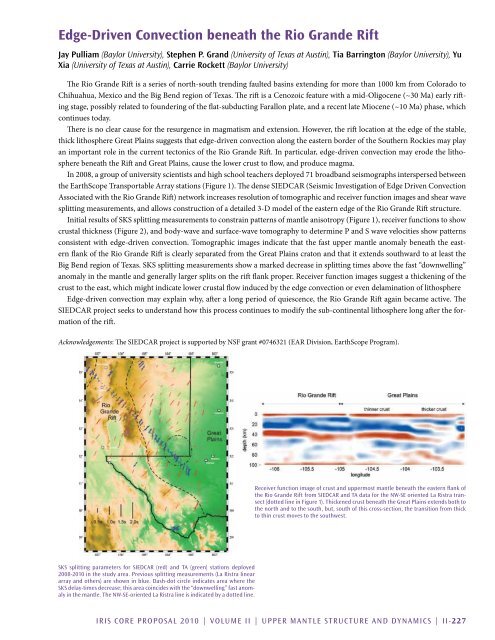Accomplishments - IRIS
Accomplishments - IRIS
Accomplishments - IRIS
Create successful ePaper yourself
Turn your PDF publications into a flip-book with our unique Google optimized e-Paper software.
Edge-Driven Convection beneath the Rio Grande Rift<br />
Jay Pulliam (Baylor University), Stephen P. Grand (University of Texas at Austin), Tia Barrington (Baylor University), Yu<br />
Xia (University of Texas at Austin), Carrie Rockett (Baylor University)<br />
The Rio Grande Rift is a series of north-south trending faulted basins extending for more than 1000 km from Colorado to<br />
Chihuahua, Mexico and the Big Bend region of Texas. The rift is a Cenozoic feature with a mid-Oligocene (~30 Ma) early rifting<br />
stage, possibly related to foundering of the flat-subducting Farallon plate, and a recent late Miocene (~10 Ma) phase, which<br />
continues today.<br />
There is no clear cause for the resurgence in magmatism and extension. However, the rift location at the edge of the stable,<br />
thick lithosphere Great Plains suggests that edge-driven convection along the eastern border of the Southern Rockies may play<br />
an important role in the current tectonics of the Rio Grande Rift. In particular, edge-driven convection may erode the lithosphere<br />
beneath the Rift and Great Plains, cause the lower crust to flow, and produce magma.<br />
In 2008, a group of university scientists and high school teachers deployed 71 broadband seismographs interspersed between<br />
the EarthScope Transportable Array stations (Figure 1). The dense SIEDCAR (Seismic Investigation of Edge Driven Convection<br />
Associated with the Rio Grande Rift) network increases resolution of tomographic and receiver function images and shear wave<br />
splitting measurements, and allows construction of a detailed 3-D model of the eastern edge of the Rio Grande Rift structure.<br />
Initial results of SKS splitting measurements to constrain patterns of mantle anisotropy (Figure 1), receiver functions to show<br />
crustal thickness (Figure 2), and body-wave and surface-wave tomography to determine P and S wave velocities show patterns<br />
consistent with edge-driven convection. Tomographic images indicate that the fast upper mantle anomaly beneath the eastern<br />
flank of the Rio Grande Rift is clearly separated from the Great Plains craton and that it extends southward to at least the<br />
Big Bend region of Texas. SKS splitting measurements show a marked decrease in splitting times above the fast “downwelling”<br />
anomaly in the mantle and generally larger splits on the rift flank proper. Receiver function images suggest a thickening of the<br />
crust to the east, which might indicate lower crustal flow induced by the edge convection or even delamination of lithosphere<br />
Edge-driven convection may explain why, after a long period of quiescence, the Rio Grande Rift again became active. The<br />
SIEDCAR project seeks to understand how this process continues to modify the sub-continental lithosphere long after the formation<br />
of the rift.<br />
Acknowledgements: The SIEDCAR project is supported by NSF grant #0746321 (EAR Division, EarthScope Program).<br />
Receiver function image of crust and uppermost mantle beneath the eastern flank of<br />
the Rio Grande Rift from SIEDCAR and TA data for the NW-SE oriented La Ristra transect<br />
(dotted line in Figure 1). Thickened crust beneath the Great Plains extends both to<br />
the north and to the south, but, south of this cross-section, the transition from thick<br />
to thin crust moves to the southwest.<br />
SKS splitting parameters for SIEDCAR (red) and TA (green) stations deployed<br />
2008-2010 in the study area. Previous splitting measurements (La Ristra linear<br />
array and others) are shown in blue. Dash-dot circle indicates area where the<br />
SKS delay-times decrease; this area coincides with the “downwelling” fast anomaly<br />
in the mantle. The NW-SE-oriented La Ristra line is indicated by a dotted line.<br />
<strong>IRIS</strong> Core Proposal 2010 | Volume II | Upper Mantle Structure and Dynamics | II-227

















